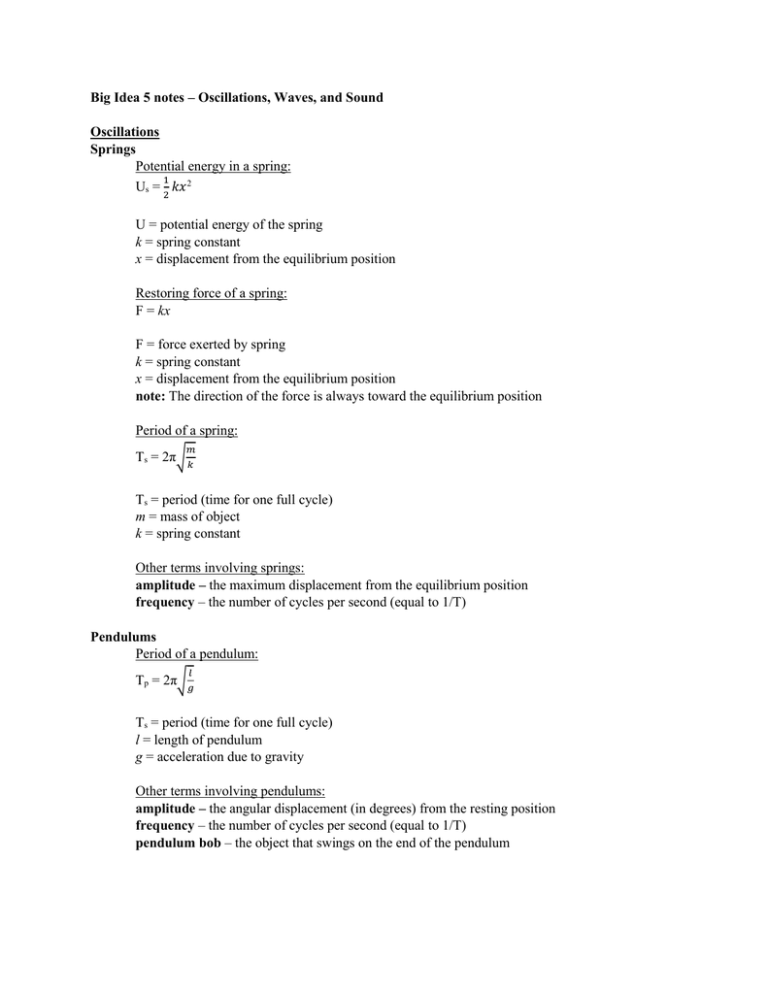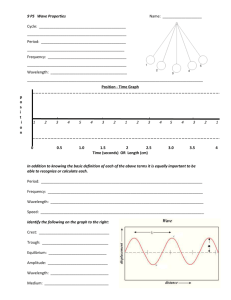Big Idea 5 notes – Oscillations, Waves, and Sound Oscillations
advertisement

Big Idea 5 notes – Oscillations, Waves, and Sound Oscillations Springs Potential energy in a spring: 1 Us = 𝑘𝑥2 2 U = potential energy of the spring k = spring constant x = displacement from the equilibrium position Restoring force of a spring: F = kx F = force exerted by spring k = spring constant x = displacement from the equilibrium position note: The direction of the force is always toward the equilibrium position Period of a spring: 𝑚 𝑘 Ts = 2π√ Ts = period (time for one full cycle) m = mass of object k = spring constant Other terms involving springs: amplitude – the maximum displacement from the equilibrium position frequency – the number of cycles per second (equal to 1/T) Pendulums Period of a pendulum: 𝑙 Tp = 2π√𝑔 Ts = period (time for one full cycle) l = length of pendulum g = acceleration due to gravity Other terms involving pendulums: amplitude – the angular displacement (in degrees) from the resting position frequency – the number of cycles per second (equal to 1/T) pendulum bob – the object that swings on the end of the pendulum Waves Types of waves: Mechanical vs. Electromagnetic waves: All waves are either mechanical or electromagnetic. A mechanical wave, such as sound, requires a medium to transmit the energy of the wave. A medium can be any type of matter (solid, liquid, or gas). Without a medium, such as would be the case in the vacuum of space, no energy would be transferred. In the case of a sound wave, you wouldn't hear anything in space. Electromagnetic waves, such as light, do not require a medium to transmit their energy. Sunlight reaches our planet, even through the vacuum of space. Transverse vs. longitudinal waves: All waves are transverse, longitudinal, or a combination of the two. In a transverse wave, the particles vibrate in a direction perpendicular to the direction of the wave energy. Light waves are an example. In a longitudinal wave, the particles vibrate in a direction parallel to the direction of the wave energy. Sound waves are an example. Wave terms: wavelength – the length of a single complete wave (crest to crest) frequency – the number of waves that pass a given point in one second period – the time required for a complete wave to pass (equal to 1/f) amplitude – the displacement from a crest to the resting position, directly related to the amount of energy being transferred velocity – the speed of the wave, which is dependent upon the medium (3.00 x 108 m/s for electromagnetic waves in a vacuum) Wave interference: constructive interference – occurs whenever two waves meet crest to crest or trough to trough (the amplitudes are added when the waves meet) destructive interference – occurs whenever two waves meet crest to trough or trough to crest (the amplitudes will partially or fully cancel each other) Reflected waves: rigid boundary – when a wave bounces off of a rigid boundary, the reflected wave will be inverted (a crest will become a trough and vice versa) loose boundary – when a wave bounces off a loose boundary, the reflected wave will be erect (a crest will remain a crest) Transmission vs. reflection: Whenever a wave encounters a new medium, a portion of the energy is transmitted (continues into the new medium) and a portion is reflected back into the original medium. The greater the difference in density between the media, the greater the reflected portion and the less that will be transmitted. Standing wave: A standing wave can occur when a wave moving from its source is continuously moving toward reflected waves of the same frequency. A wave is produced that will include points of maximum amplitude (antinodes) alternating with points of zero movement (nodes). The antinodes will be twice the amplitude of the original wave due to constructive interference. The nodes will have a zero amplitude due to destructive interference. Sound Properties of sound waves: amplitude = volume frequency = pitch (higher frequency = higher pitch) velocity = depends on the medium (343 m/s in air at room temperature) Echo location: 𝑥 To determine the distance from a particular object using echo location, the equation v = 𝑡 can be used. However, the distance to the object will be half of the total displacement, since the sound must travel there and back. Doppler effect: Whenever the observer of a sound is moving relative to the source of the sound, a different frequency will be observed than what is actually emitted. When the source and observer are moving toward one another, the apparent frequency will be greater than the actual frequency. When the source and observer are moving away from one another, the apparent frequency will be lower than the actual frequency. Resonance: When small forces are applied to an object with a frequency that matches the natural frequency of the object, large increases in amplitude can occur. This phenomenon is known as resonance. Open pipe resonators: A pipe that is open on both ends will resonate when it has an antinode at each end with at least one node in between. The pipe will resonate if the length of the pipe matches any multiple of 1/2 the wavelength of the wave. Closed pipe resonators: A pipe that is open on one end will resonate when it has an antinode at the open end with a node at the closed end. The pipe will resonate if the length of the pipe matches any odd multiple of 1/4 the wavelength of the wave. Fundamental frequency and harmonics: The fundamental frequency is the lowest frequency that will resonate in a particular length of pipe. The pipe will be exactly 1/2 the wavelength of the wave for an open pipe and exactly 1/4 the wavelength of the wave for a closed pipe. The fundamental frequency is also referred to as the first harmonic (f1). The second harmonic (f2) is double the fundamental frequency. The third harmonic (f3) is triple the fundamental frequency, and so on. Beat frequency: When two sounds are played simultaneously at different frequencies, the difference between frequencies, in Hz, will be the number of 'beats' heard every second.





